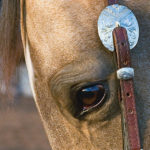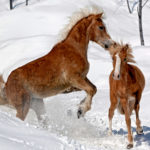With winter halfway over, this is a good time to assess whether your feeding program is still meeting your horse’s needs. A regimen that worked well at the beginning of the season may require adjustments as the weather grows colder, and blankets or heavy winter coats can easily hide critical changes in a horse’s weight.

If your horse has gained excess weight, you’ll want to cut back on his calories. Some horses, like people, are apt to put on a few extra pounds if their activity level is curtailed by cold weather. But that added weight can adversely affect a horse’s health in many ways, from extra strain on his joints to metabolic stresses, so you’ll want to get ahead of the problem before the lush spring grass arrives and makes it even more difficult. Several strategies can help:
• Switch to a lower-calorie feed made for less active horses. A wide array of feeds formulated for specific stages of life and activity levels are now available. (Simply feeding less of your current feed may shortchange him on nutrients, so check the minimum recommended amounts before trying that approach.)
• Evaluate how you are feeding hay. Forage is important to your horse’s digestive health—and it is typically less calorie-dense than concentrates—but feeding large quantities of very nutrient-rich hay can lead to weight gain. Consult with your veterinarian about the appropriate amount and type of hay for your horse. Slow feeders and small-holed hay nets can keep a horse busy while eating less.
• Consider feeding a ration balancer product, if you cut back dramatically on grain, to ensure your horse’s vitamin, mineral and other nutritional needs are still met.
If your horse is losing weight, you need to safely increase his calories. Horses burn calories to stay warm, and if he’s not getting enough when the temperatures drop, he’ll lose weight.
Older horses are especially prone to winter weight loss, and if you don’t address the situation promptly, it can take a long time to get them back to a healthy weight in spring. You have several options:
• Switch to a higher calorie feed. Simply dumping an extra scoop of regular feed into the bucket can cause dangerous overloads of carbohydrates and sugars. Instead, switch to a fat-based, calorie-rich feed formulated to safely add weight to a thin horse.
• Add a meal to his day. If your horse is already eating two large meals of an appropriate feed, add a third if you can. This increases his overall calorie intake without dangerously large meals.
• Pour vegetable oil over his ration. Drizzling up to a cup of corn oil over your horse’s feed each day is an easy and safe way to add calories to his diet. Introduce oil incrementally to avoid diarrhea.
• Increase his hay ration. Hay “burns” hotter and slower in a horse’s gut and keeps him warmer longer than an equivalent portion of grain. Ideally, a thin horse would have access to free-choice hay throughout the winter. If your hay reserves are starting to run out, consider supplementing your horse’s ration with hay cubes or a complete pelleted feed that includes forage until you can have more hay delivered. It is important, however, to plan ahead for this switch, slowly adding the complete feed to his diet as your hay supplies dwindle. Making an abrupt change in forage sources can lead to colic and other dangerous digestive problems.





